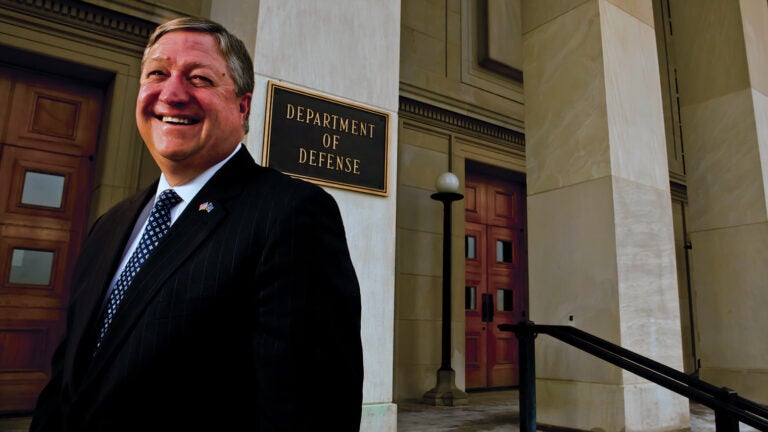
An (Air) Force of Nature
The blindingly shiny floors and fluorescent lights overhead seemed to go on forever in the long walk through the jagged corridors of the Pentagon.
Past the conference room of the joint chiefs — The Tank — where golden curtains adorn tightly shuttered faux windows, past the endless oil paintings of colorfully decorated military leaders, is the United States Air Force Office of the Secretary.
In the 17.5 miles of corridors, it is a seven-minute walk from the entrance.
Secretary Michael Donley has an affable Everyman smile. He settles into a gold and ultramarine-blue striped club chair in his office. Nearby, detailed model Air Force aircraft appear to be taking off from a wooden table. It is where he regularly meets with his military counterpart Gen. Norton Schwartz.
Troubleshooting doesn’t begin to describe what the air service’s top civilian leader and the four-star general must accomplish amid these four walls.
“We’re not pretending mistakes were not made,” Donley candidly said. “That’s definitely a responsibility of leadership.”
Donley was referring to the incident in 2007, when six nuclear warheads were mistakenly loaded on an Air Force plane that flew over the U.S. News broke a year later that nuclear missile components had been shipped to Taiwan in error.
The Pentagon’s director of administration and management at the time, Donley was recruited to restore credibility to and revamp the Air Force system.
“Those were pretty serious missteps,” Donley said. “So the chief and I have focused on strengthening our oversight and stewardship of the nuclear enterprise.”
The two have the task of rebuilding the nuclear component in the air and space power branch of the U.S. Armed Forces. As secretary, Donley is responsible for more than 334,000 men and women on active duty; 176,000 Air National Guard and Air Force Reserve members; and 170,000 civilians. He oversees the Air Force’s annual budget of more than $110 billion.
Hanging on walls inside his office are paintings of Air Force aircraft throughout history — including a large one of an F-22 Raptor stealth fighter. In 2009, Donley and Schwartz, with Secretary of Defense Robert Gates, decided to close out production of the F-22 — the Air Force’s most advanced fighter — one of many politically charged budget decisions Donley must make routinely.
“We’re redirecting resources inside the Air Force and that has meant terminating production of aircraft we think we have sufficient quantities of today,” Donley said. “We’re refocusing those dollars on new and emerging capabilities.”
In February, Donley and Air Force Chief of Staff Schwartz spoke before the House Armed Services Committee, requesting $150 billion in the baseline budget and $16 billion for overseas operations. Delaying the appropriations bill would negatively impact U.S. military operations in Iraq and Afghanistan, Donely and Schwartz warned.
Right now, nearly 40,000 airmen are deployed to 263 locations across the globe. Among the Air Force’s priorities is providing support to U.S. Central Command and coalition forces in Iraq and Afghanistan.
Living and breathing all things military, Donley was born in 1952 at Hamilton Air Force Base in Novato, Calif.
Destiny?
“More of a coincidence than anything else,” Donley countered, adding that his father, an insurance broker, had served in the Air Force for a short time. Donley grew up during the Yom Kippur War of 1973, the Turkish invasion of Cyprus in 1974, and the Vietnam War, followed by the Fall of Saigon in 1975.
At 19, after two years at El Camino College, his draft number, relatively low at No. 66, was picked. The Army sent him to Fort Bragg, N.C., to work as an intelligence specialist. After three years, he was accepted to the USC School of International Relations. He earned his bachelor’s in 1977 and master’s a year later. At USC Dornsife, he studied national and international security.
“I knew then that I would come to D.C.,” he said. “There were USC alumni in D.C. who got there a year or two ahead of me. I had a network to help me get started.”
In 1978, he snagged his first job as editor of the National Security Record. Developing contacts on Capitol Hill, he became legislative assistant in the U.S. Senate, then a staffer on the Senate Armed Services Committee.
He was director of defense programs at the National Security Council (NSC) when he approached Colin Powell, then-deputy national security adviser.
“Sir, I’ve been here at the NSC three-plus years,” he recalled telling Powell in 1987. “Unless you have something new for me to do, my intent is to try to find work over at the Pentagon.”
That day, Secretary of Defense Caspar Weinberger announced his retirement and Frank Carlucci became the secretary of defense. Powell became national security adviser and promoted Donley to deputy executive secretary overseeing the White House Situation Room. Donley coordinated the White House policy on the Goldwater-Nichols Department of Defense Reorganization Act and wrote the national security strategy for President Ronald Reagan.
In 1989, Donley was appointed assistant secretary of the Air Force, and later acting secretary. In 1993, Donley left government work to do private consulting — until the Pentagon came calling in 2005.
“Sometimes,” he said, “the jobs choose you.”
“I knew then that I would come to D.C. There were USC alumni in D.C. who got there a year or two ahead of me. I had a network to help me get started.”
Read more articles from USC Dornsife Magazine’s Spring/Summer 2011 issue